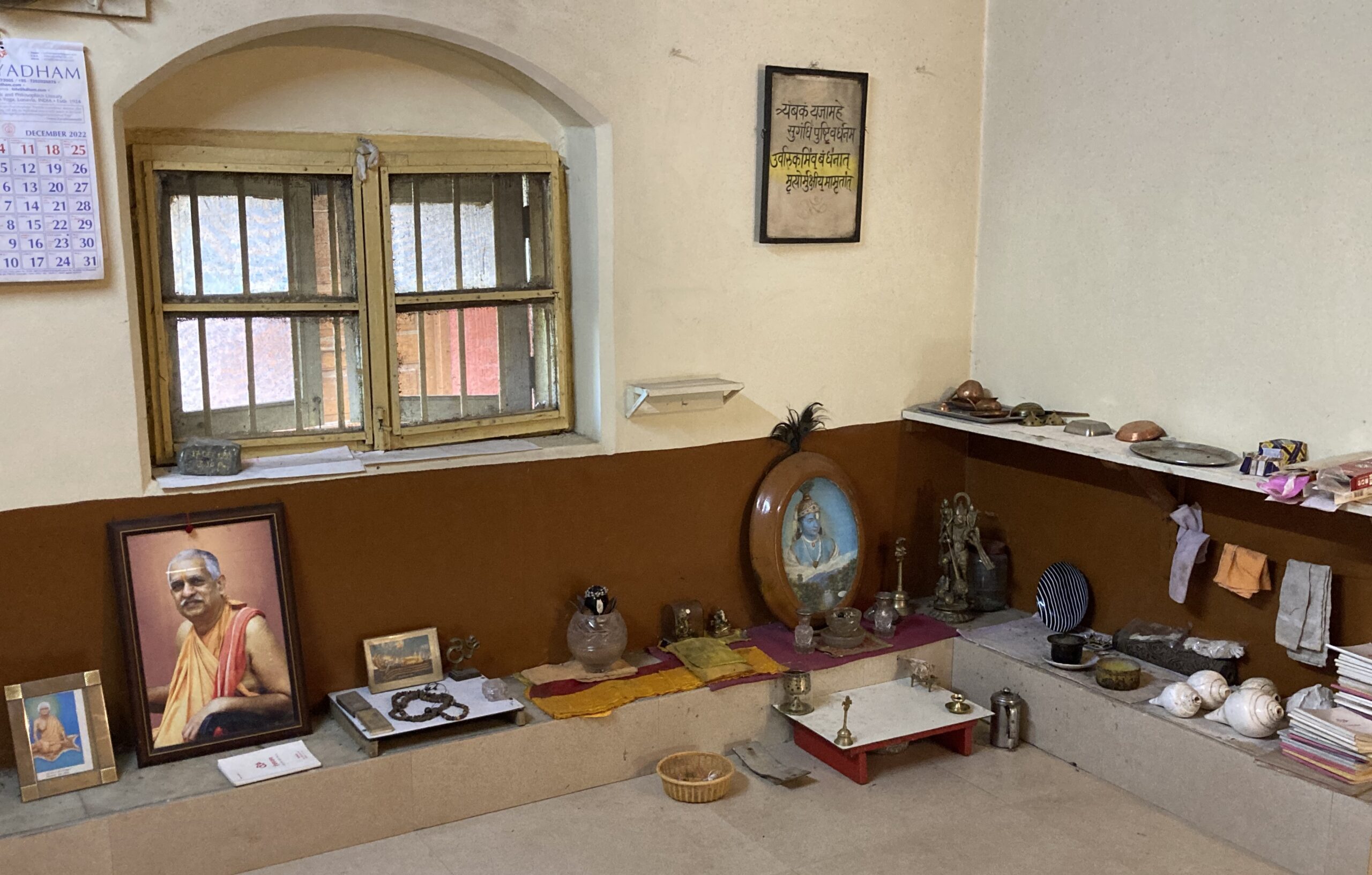
Writings: Lifestyle
In the summer of 2007 Swamiji handed me this correspondence he had prepared a few years earlier for a retreat in Amrum (Germany).
It’s a long read, and one best done slowly – feel free to walk away, ponder and return again and again allowing the words to slowly seep into the thinking mind.
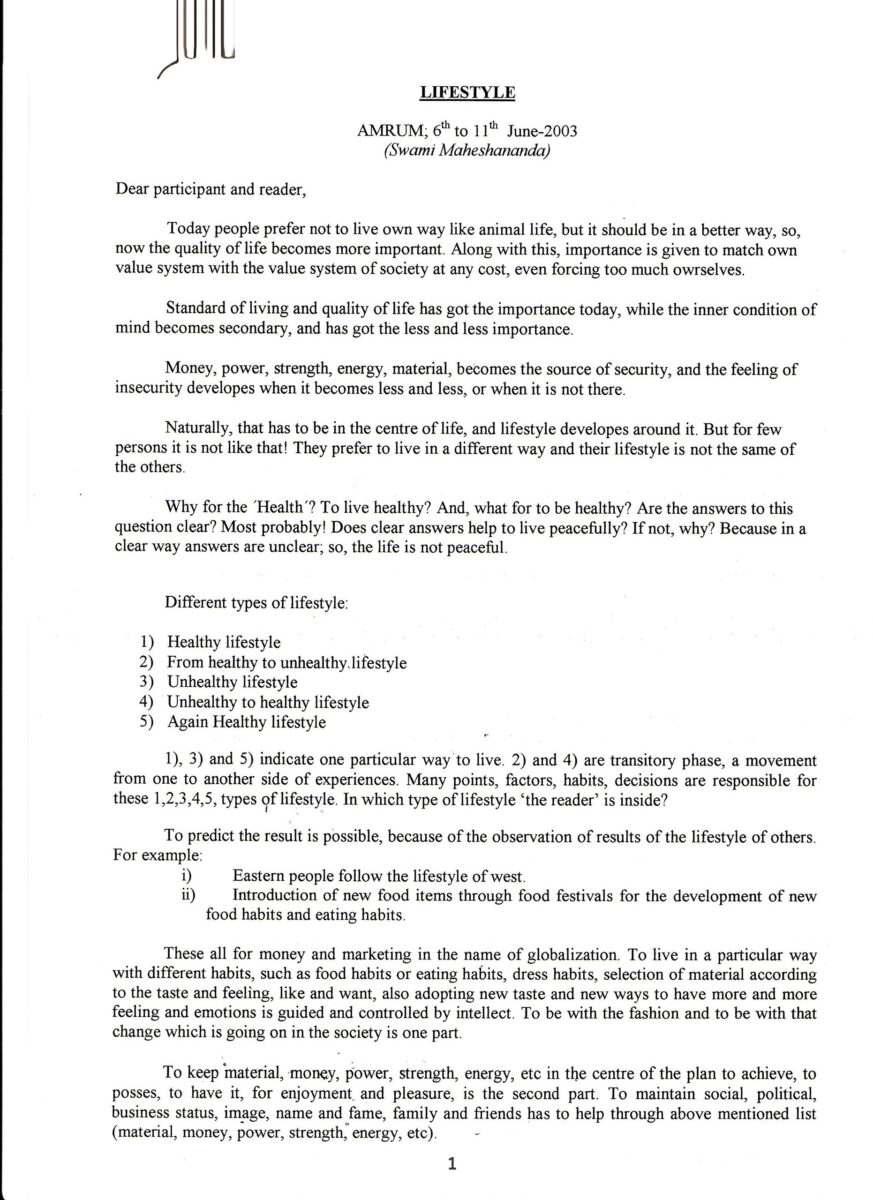
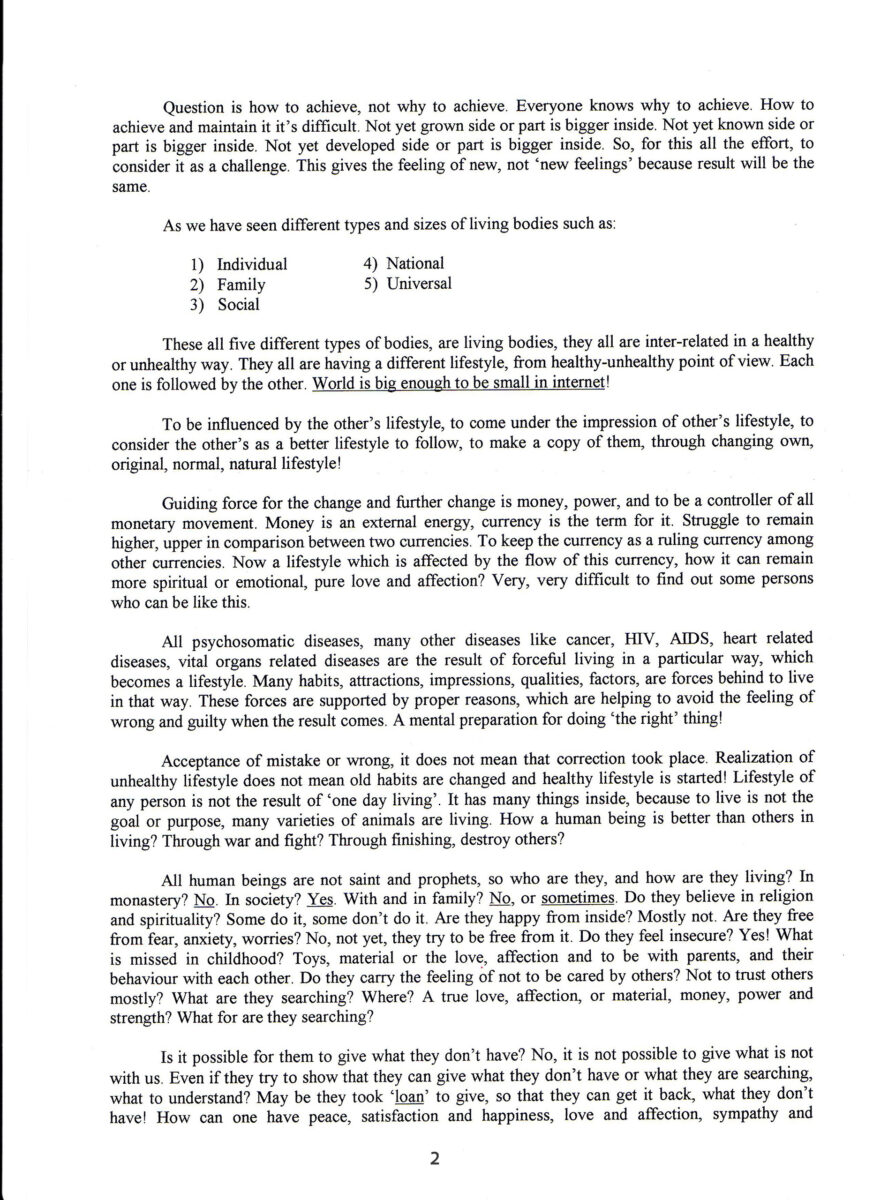
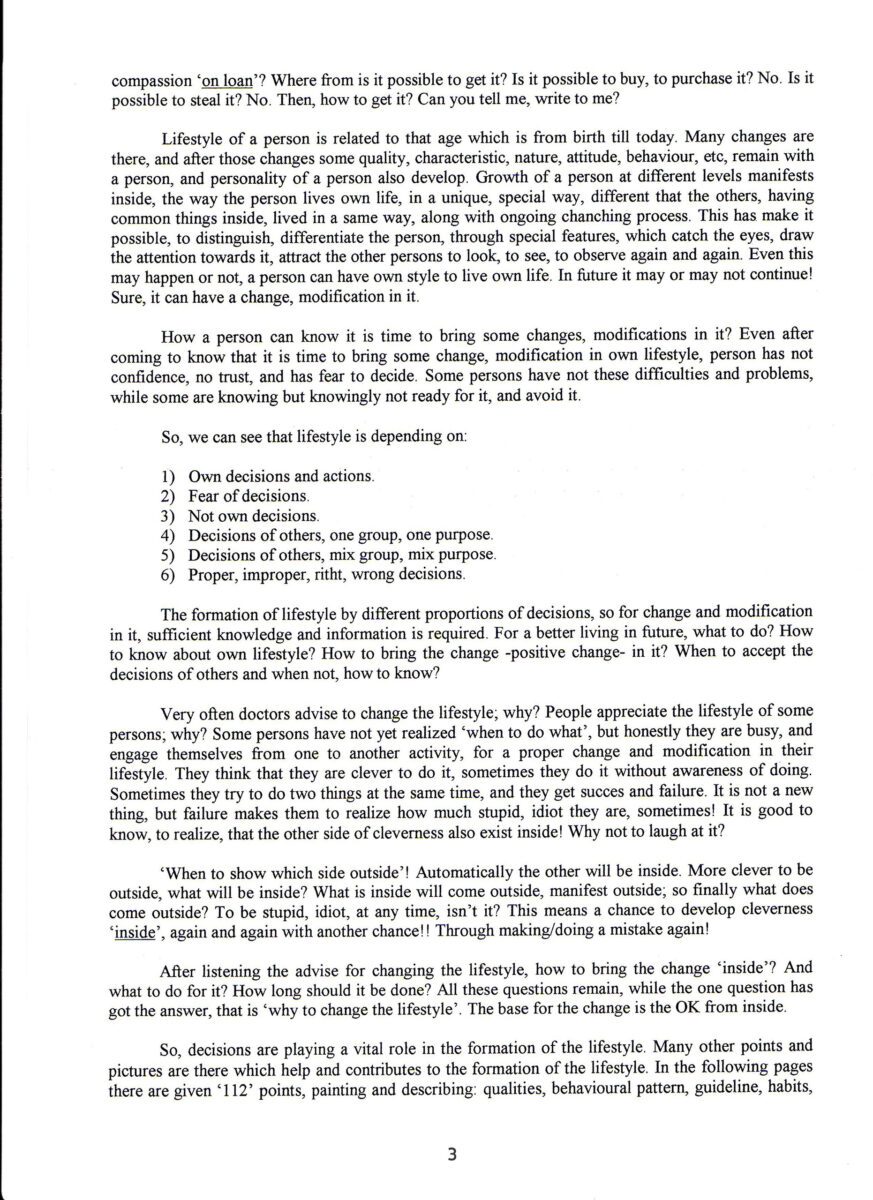
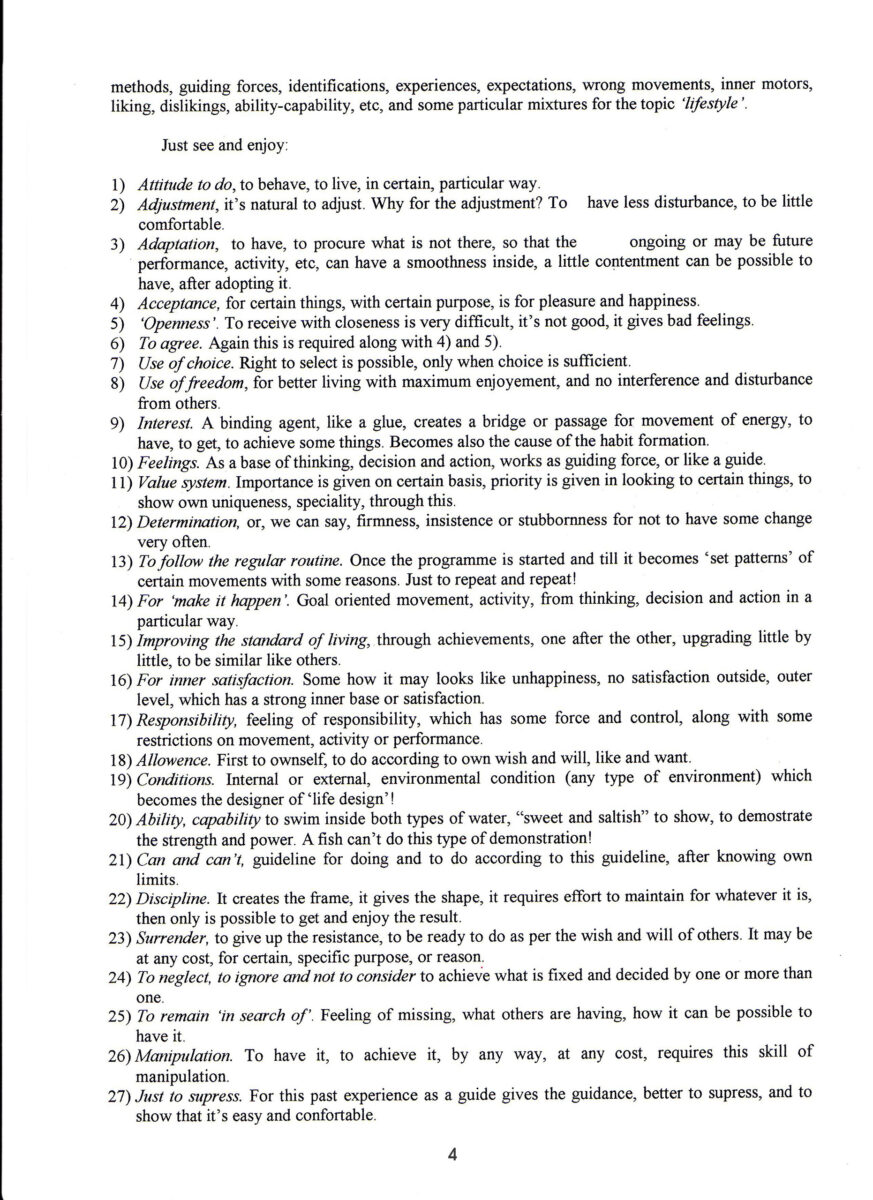
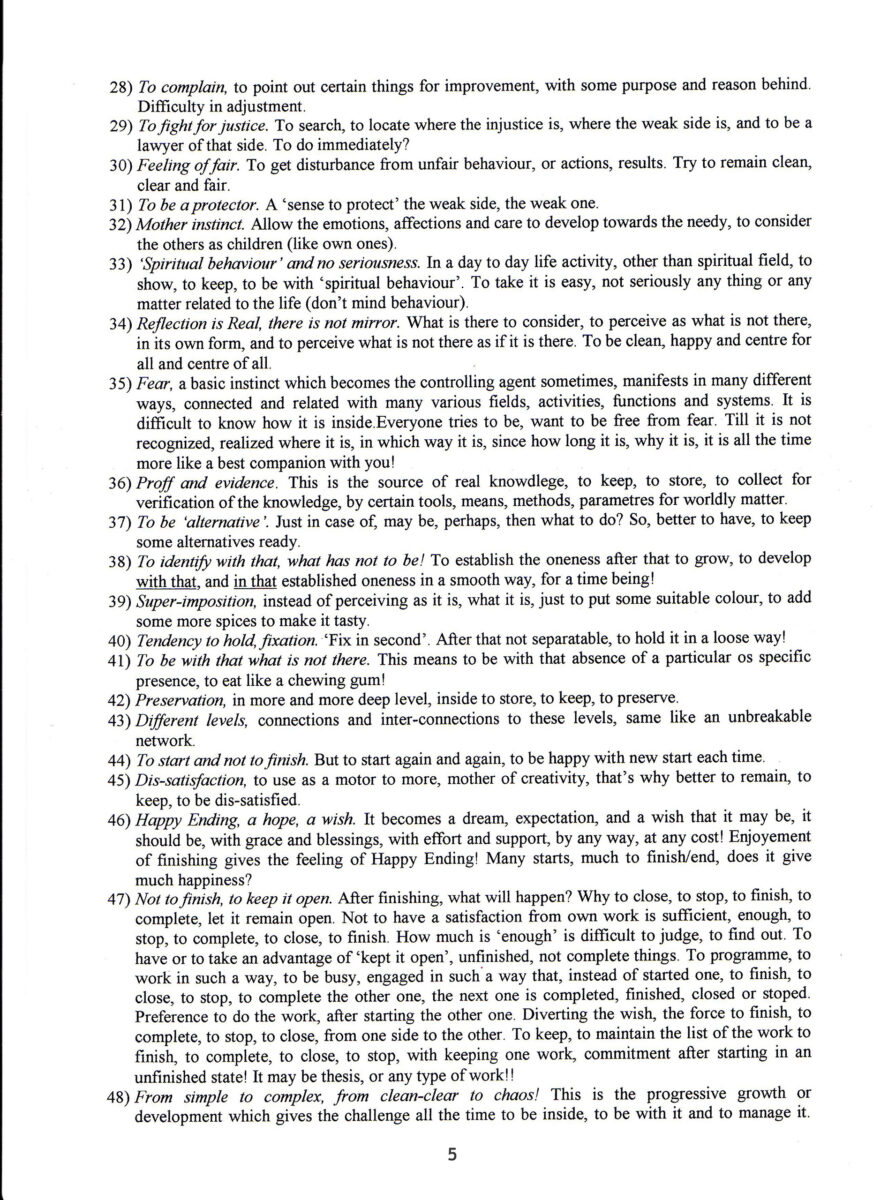
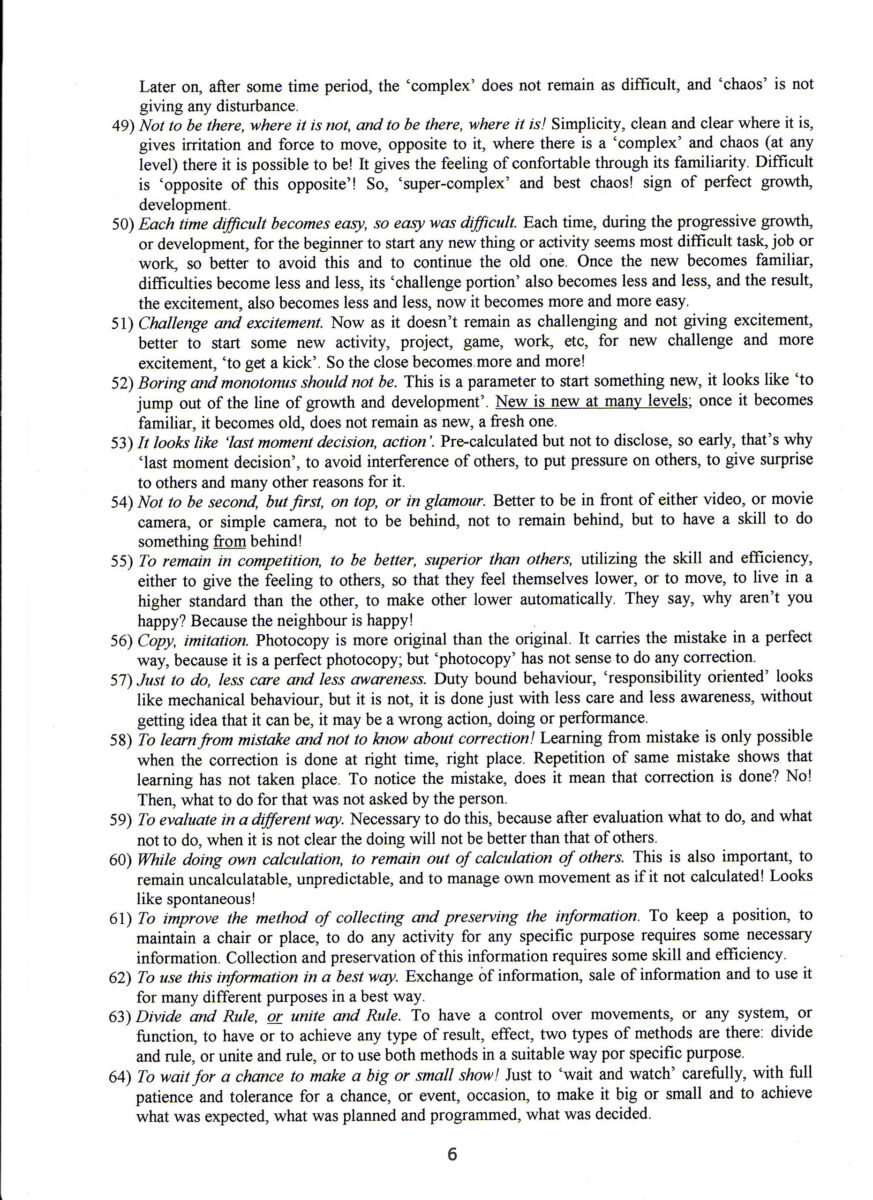
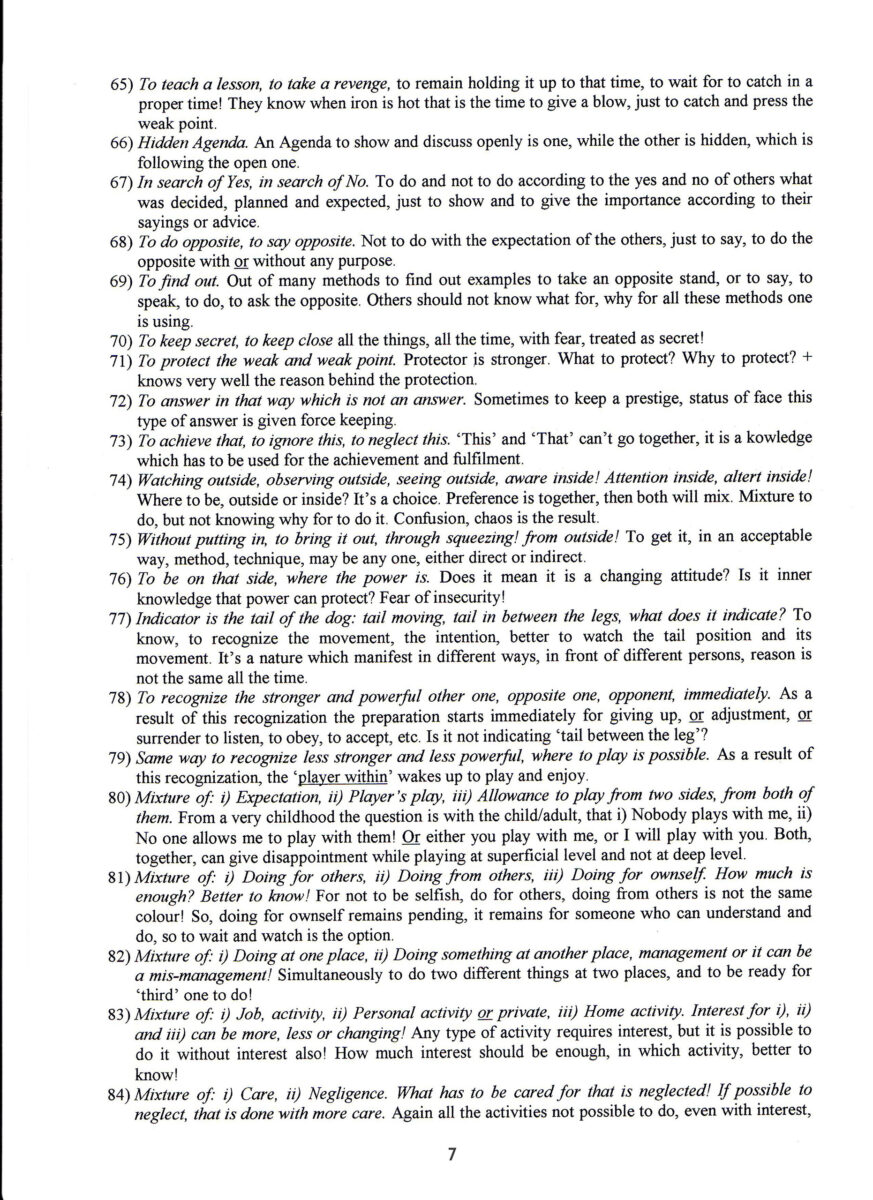
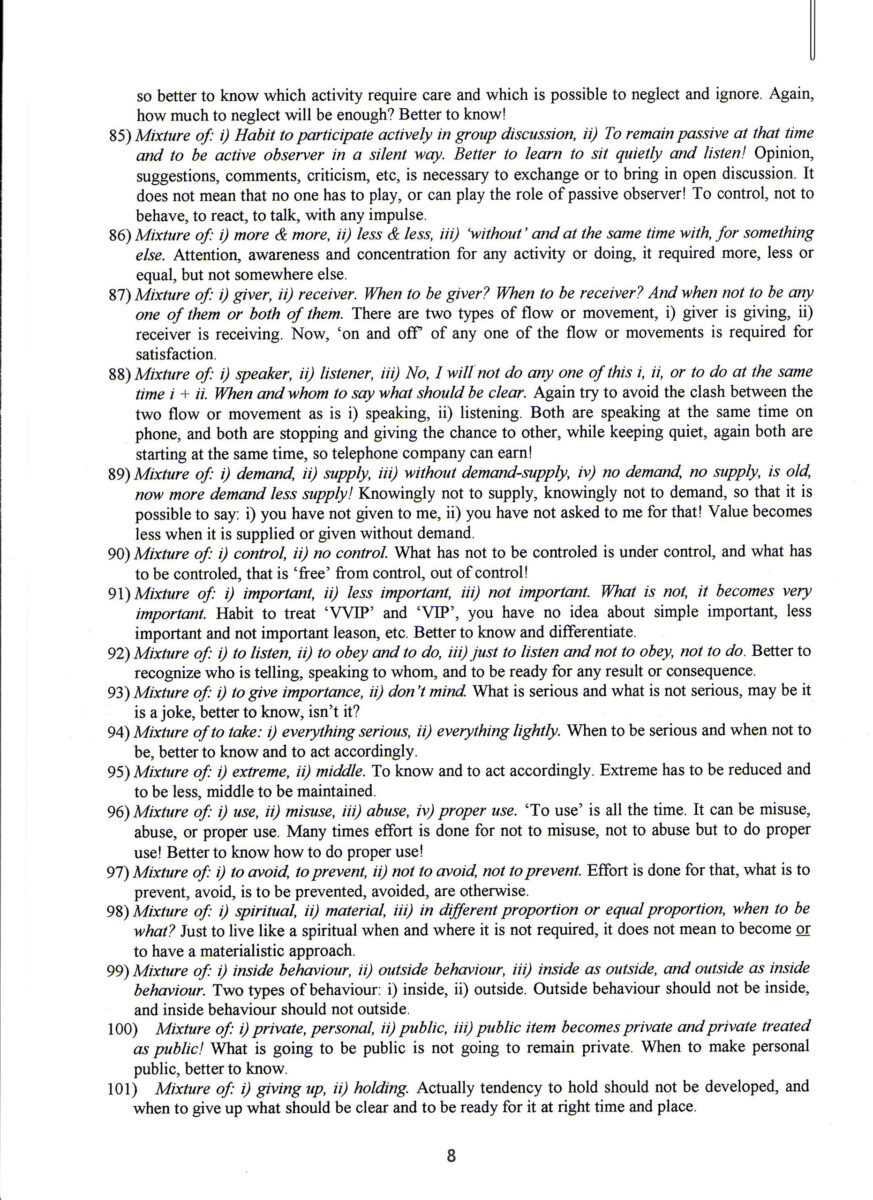
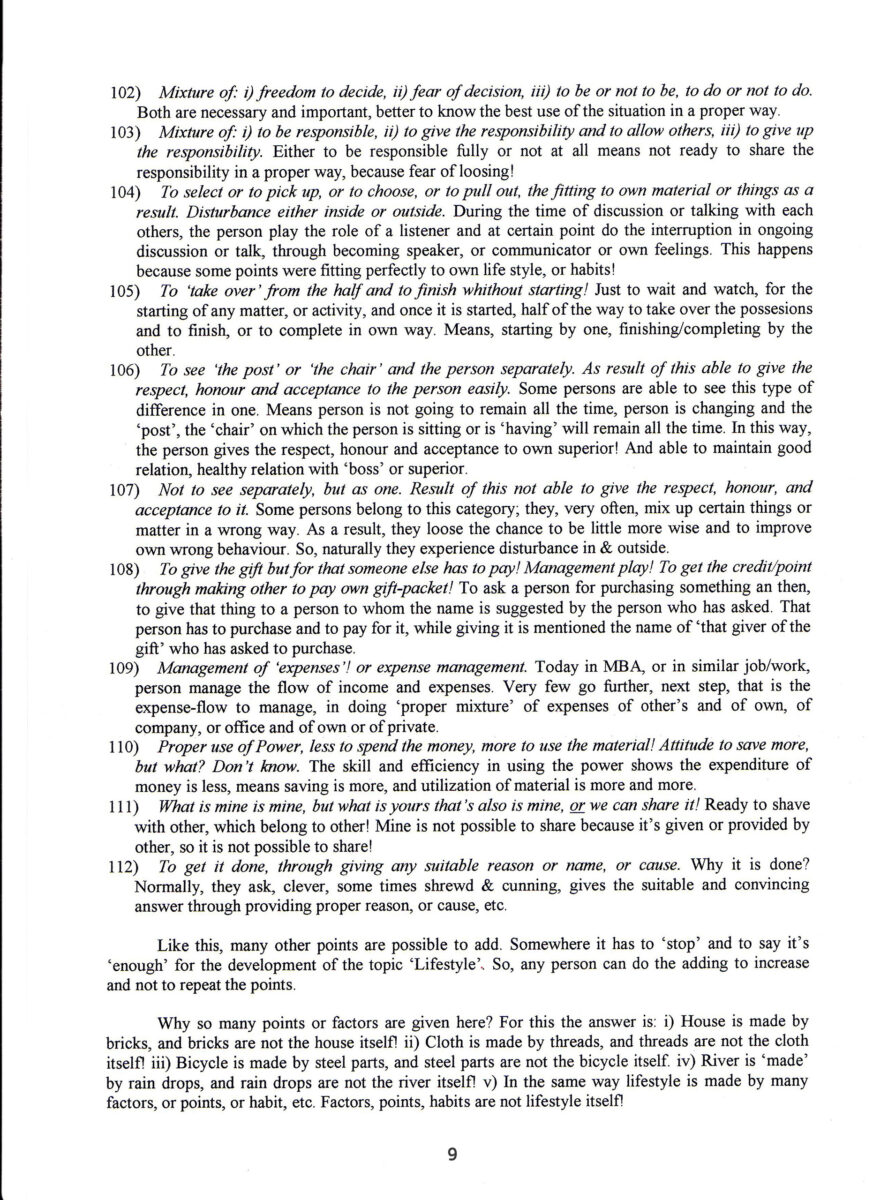
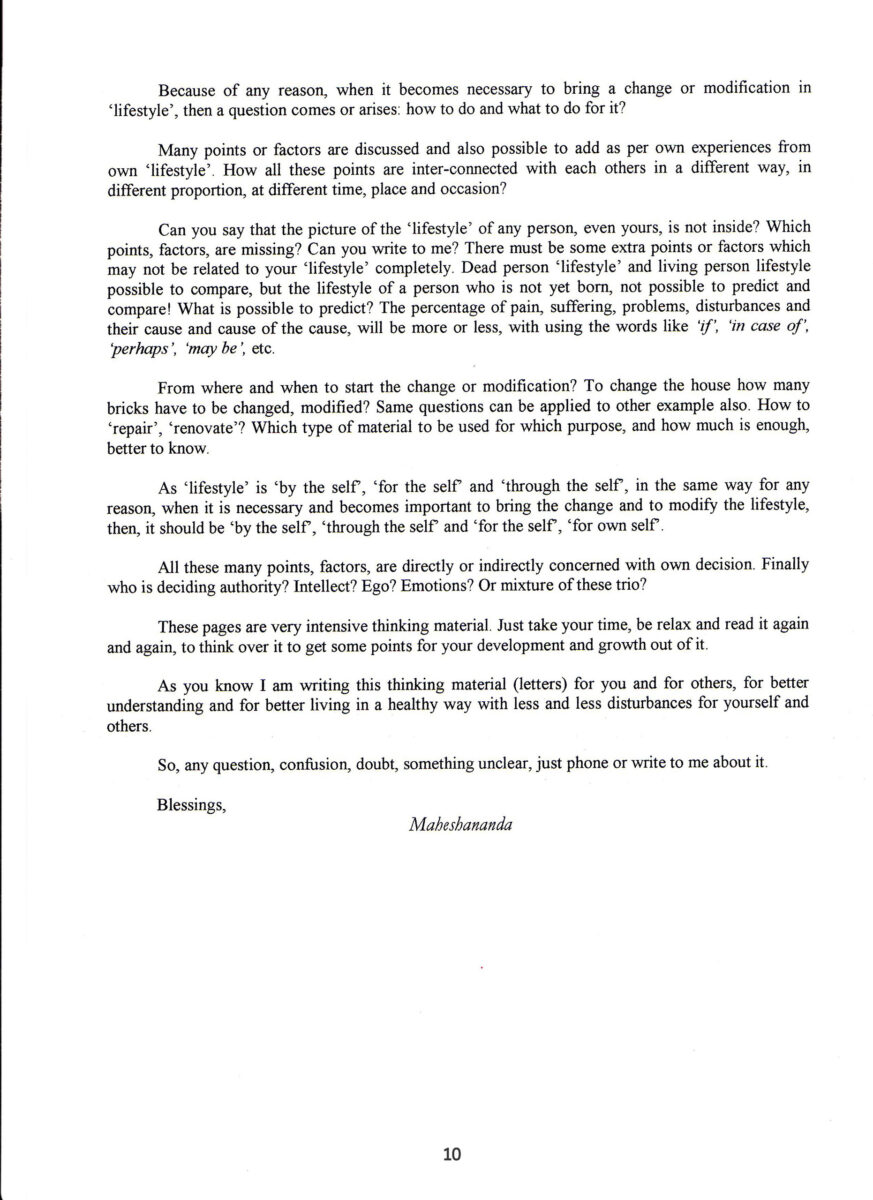
Interpretation
Below is a lightly edited version of this correspondence to aid those unfamiliar with Swamiji’s manner of speech.
Dear Reader,
Today people prefer not to live like animals – life should be lived in a better way. The quality of life has become supremely important. With this importance, comes the question: How do we match our values, to the values of society? It can often lead to forcing ourselves too much.
Today, the standard of living and our quality of life is given great importance. While the inner condition of the mind becomes secondary. It has less, and less importance.
Money. Power. Strength. Energy. Material. All become sources of security. And the feeling of insecurity grows when they become less, and less, or when they are not even there.
This has become the focus of life and our lifestyles have developed around it. But, for a few people it is not like that – they prefer to live in a different way. Their lifestyle is not the same as others.
What is Health? What does it mean to live healthily? And, why be healthy? Are the answers to these questions clear? Most probably! But do clear answers help you to live peacefully? If not, why not? Because in a clear way, the answers remain unclear. And so, life is not peaceful.
There are different types of lifestyles:
• Healthy
• From healthy to unhealthy
• Unhealthy
• From unhealthy to healthy
• The return to healthy
The first, third, and last are a particular way of living. The second and the fourth are transitory, a phase, as we move from one experience to another. Many factors, habits and decisions are responsible for our lifestyle choice.
In which type of lifestyle are you?
It is possible to predict the result. We can observe the lifestyle of others. For example:
i) Eastern people following the lifestyle of the West.
ii) The introduction of new food items through food festivals to develop new food and eating habits.
Why does this happen? For money, in the name of globalisation. To promote a particular way of living, with different habits – what is eaten, how it is eaten, what is worn, the list goes on.
The selection of anything according to taste and how it feels, likes and wants, adopting new tastes and new ways. All this has to do with our feelings and emotions, guided and controlled by the intellect. The desire to be with the fashion; to be with the change that is going on in society. This is one part.
The second is money, power, strength, energy and material. These are kept in the centre of the plan: the aim is to achieve, to possess and to enjoy. To maintain social and political status, image, family and friends. All this is aided by money, power, strength, energy and material.
The question has become how to achieve this, not why. Everyone knows what to achieve. But it is difficult to achieve it and to maintain it. We consider it a challenge; we make such efforts. It gives the feeling of something new; not “new feelings” because the result will be the same.
The not yet grown side, or part, is bigger inside. The not yet known side, or part, is bigger inside. The not yet developed side, or part, is bigger inside.
We can see different types and sizes of living bodies:
• Individual
• Family
• Social
• National
• Universal
All five are different types of bodies. Living bodies. They are all inter-related in a healthy, or unhealthy way. They all have different lifestyles, from the healthy/unhealthy point of view. Each one follows the other.
The world is big enough to be small on the web to be influenced by another’s lifestyle, to come under the impression of another’s lifestyle, to consider another’s lifestyle as a better lifestyle to follow, to make a copy of that lifestyle by changing your own, original, normal, natural lifestyle.
The guiding force for the change, and for further change is money; power; and the desire to be the controller of monetary movement. Money is an external energy. Currency is the term for it.
There is always a struggle to remain the better, or more in comparison to another currency: to keep your currency as a ruling currency among other currencies.
Now, a lifestyle which is affected by the flow of this currency. Can it remain spiritual or emotional, of pure love and affection? It is very, very difficult to find people who can be like this.
All disease – psychosomatic, cancer, heart disease. All disease is the result of forceful living, in a particular way, which in turn becomes a lifestyle. Habits, attractions, impressions, qualities, factors, all these are forces behind why we live the way we live. These forces are supported by our “proper” reason and logic. And our reason and logic help us to avoid the feeling of wrong and guilt when the results of our lifestyle come home. They are our mental preparation for doing “the right” thing!
When a mistake or “wrong doing” is accepted, does it mean that a correction takes place? It does not. It does not follow that a correction was made. The realisation of an unhealthy lifestyle does not mean that old habits are changed, and a healthy lifestyle has begun.
The lifestyle of any person is not the result of one day of living. It has many things inside. Just “to live” is not the goal or purpose – there are many species of animals “living”. How is a human being living in a better way? Through war and fighting? Through finishing and destroying others?
All human beings are not saints and prophets.
So, who are they, and how are they living? In a monastery? No. In society? Yes. With, and in, a family? No, maybe sometimes. Do they believe in religion and spirituality? Some do; some don’t.
Are they happy from inside? Mostly not. Are they free from fear, anxiety and worries? No. Not yet, but they try to be free from it. Do they feel insecure? Yes!
What is missed in childhood? Toys? Material possessions? Or, the love and affection and ‘to be’ with their parents? Do they carry the feeling of not being cared for by others? Not to trust others? What are they searching for, and where? A true love? Affection? Or, material, money, power and strength? What are they searching for?
Is it possible for them to give what they do not have? No. It is not possible to give what is not with us. Even if they try to show that they can give what they don’t have, or what they are searching for. It is not possible.
Maybe they took a “loan” so that they can give; so that they can get back what they don’t have. How can one have peace, satisfaction and happiness, love and affection, sympathy and compassion “on loan”? Where is it possible to get this? Is it possible to purchase, or buy it? No. Is it possible to steal it? No. How, then is it possible to get it. Can you tell me?
The lifestyle of a person begins at birth until today. Many changes happen, and after those changes some qualities, characteristics, the nature, attitudes or behaviours remain with the person; and so their personality develops. The growth of a person at different levels manifests inside – the way they live their life is unique. It is different from others, although it has common things inside – it is lived in the same way and has an ongoing changing process.
This uniqueness makes it possible to distinguish, differentiate, and identify special features that catch the eye and draw the attention towards it: it attracts other people to look, to see, and to observe again and again. Now, whilst this may, or may not happen, a person certainly has their own style to live their own life. In the future it may continue in this way, or it may not. It may change and modify.
How can a person know it is time to bring in some changes, to modify it? Then, even after coming to know that it is time to bring in change and modify their own lifestyle, the person does not have the confidence, they have no trust, they fear making a decision. Some people don’t have these difficulties and problems. Whilst others are knowing but, are knowingly not ready for it. And so, avoid it.
Thus, we can see lifestyle depends on:
• Our own decisions and actions
• A fear of decisions
• Not our own decisions
• The decisions of others – one group with one purpose
• The decisions of others – a mixed group with mixed purposes
• Proper and improper, right and wrong decisions.
Together different proportions of these decisions create a lifestyle. For change and modification to happen sufficient knowledge and information is required.
The question comes: what to do to achieve a better living? How can you know your own lifestyle? How can you bring about positive change within it? And, when to accept the decisions of others, and when not to – how can you know?
Very often doctors advise a change to the lifestyle. Why?
People appreciate the lifestyle of others. Why?
Some people have not yet realised “when to do what”, and in all honesty they are busy engaging themselves in one activity after another, hoping for a proper change in their lifestyle. They think they are clever to do this, sometimes they do it without even being aware they are doing it. Sometimes they try two things at the same time, and they get both success and failure. It is not a new thing, but failure makes them realise how stupid they are… sometimes! It is good to know, to realise, that on the other side is cleverness: it exists inside. Why not laugh at it!
Ask: what side do you want to show to the outside? Automatically the other side will be inside. If it is better to be clever outside, what will be inside? What is inside, will come outside. It will manifest outside, so finally what comes outside? To be stupid, at any time, isn’t it? This means there is a chance to develop cleverness “inside”. Again, and again the chance is given. All through making or doing a mistake again!
After listening to the advice about changing the lifestyle, how do we bring that change inside? And what do we do it for? How long should it be done? All these questions remain, while one question has got an answer: “Why change the lifestyle”? The base for the change is the OK, the willingness, from inside.
Decisions play a vital role in the formation of the lifestyle. In the following pages there are 112 points painting and describing qualities, behavioural patterns, guidelines, habits, methods, guiding forces, identifications, experiences, expectations, wrong movements, inner motors, likings, dislikings, abilities and capabilities for this topic “lifestyle”.
Just see and enjoy.
1. Attitude to do. To behave, to live in a certain, particular way.
2. Adjustment, it’s natural to adjust. What is the adjustment for? To have less disturbance, to be a little more comfortable.
3. Adaptation. To have, to procure what is not there so that what is ongoing, or maybe a future performance or activity, can have a smoothness inside. A little contentment can be had after adopting it.
4. Acceptance for certain things, with a certain purpose, is for pleasure and happiness.
5. Openness. To receive with “close-ness” is very difficult. It is not good and it gives bad feelings.
6. To agree. This is requires acceptance and openness.
7. Use of choice. The right to select is possible, but only when choice is sufficient.
8. Use of freedom for a better living with complete enjoyment, without interference and disturbance from others.
9. Interest. A binding agent, like a glue that creates a bridge or passage for the movement of energy to have, to get, to achieve something. It is the cause behind the formation of habits.
10. Feelings. As a base of thinking, decision and action. They work as a guiding force, or like a guide.
11. Value system. Importance is given on a certain basis to certain things, to show uniqueness and specialness.
12. Determination, or we can say, firmness, insistence or stubbornness to not changing very often.
13. To follow a regular routine. Once the program is started, and until it becomes a “set pattern” of certain movements with reasons behind it. Just repeat and repeat!
14. Make it happen. A goal oriented movement or activity. It comes from thinking, deciding and then acting in a particular way.
15. Improving the standard of living, through achievements, one after the other. Upgrading little by little to be similar to others.
16. For inner satisfaction. Somehow it may look like unhappiness – that there is no satisfaction outside, on the outer level – yet it has a strong inner base or satisfaction.
17. Responsibility. The feeling of responsibility has some force and control, along with restrictions on movement, activity and or performance.
18. Allowance. First to oneself, to do according to your own wish and will, like and want.
19. Conditions. Internal or external, any type of environmental condition which becomes the designer or “life design”!
20. Ability, capability to swim inside both types of water – sweet and salty – to show, to demonstrate strength and power. A fish can’t do this type of demonstration!
21. Can and can’t. A guideline for doing, and to do according to, this guideline, after knowing the limits.
22. Discipline. It creates the frame. It gives the shape. It requires effort to maintain whatever it is. Then only is it possible to get, and enjoy, the results!
23. Surrender. To give up the resistance. To be ready to do according to the wish and will of others. It may be at any cost, or for a certain specific purpose or reason.
24. To neglect, to ignore and not consider to try and achieve what is fixed and decided upon by someone else.
25. To remain “in search of”. A feeling of missing what others are having. How can it be possible to have it?
26. Manipulation. To have it, to achieve it, by any way, at any cost. This requires the skill of manipulation.
27. Just to suppress. Past experience, as a guide, gives the guidance that it is better to suppress; to show that it’s easy and comfortable.
28. To complain. To point out certain things for improvement with some purpose and reason behind. Difficulty in adjustment.
29. To fight for justice. To search, to locate where the injustice is, where the weak side is, and to be a lawyer for that side. To do it immediately?
30. Feeling of fair. To become disturbed from unfair behaviour, or actions, or the results. Try to remain clean, clear and fair.
31. To be a protector. A “sense to protect” the weak side, or the weak one.
32. Mother instinct. To allow emotions, affections, and care to develop towards the needy; to consider others as children (like their own ones).
33. “Spiritual behaviour” and no seriousness. In day-to-day life, to show, keep and be with “spiritual behaviour”. To take it easy. To not take anything, or any matter related to life seriously (don’t mind behaviour).
34. Reflection is Real, there is no mirror. To consider and to perceive what is there as what is not there. And, to perceive what is not there as if it is. To be clean, happy and the centre for all, and the centre of all.
35. Fear. A basic instinct which sometimes becomes the controlling agent. It manifests in many different ways. It is connected and related with many various fields, activities, functions and systems. It is difficult to know how it is inside. Everyone tries to be, wants to be, free from fear. Until it is fully recognised – realised where it is, in which way it is, for how long, and why it is… It is all the time, like a best companion with you!
36. Proof and evidence. This is the source of real knowledge for worldly matters. To keep, to store, to collect for verification of knowledge by certain tools, means and methods.
37. To be “alternative”. Just in case. Maybe. Perhaps. What to do then? Better to be and to keep some alternatives ready.
38. To identify with that, what has not to be! To establish oneness and after that to grow; to develop with that, and in that establishing oneness in a smooth way; for the time being!
39. Super-imposition. Instead of perceiving it as it is and what it is, just add some suitable colour; to add more spice to make it tasty.
40. Tendency to hold, fixation. “Fix in a second”. After that it is not separable, to hold in a loose way!
41. To be with what is not there. This means to be with an absence of a particular, or specific, presence. To eat like chewing gum.
42. Preservation. In deeper and deeper levels, to store inside, to keep, to preserve.
43. Different levels, connections and inter-connections to these levels, like an unbreakable network.
44. To start and not to finish. But to start again and again. To be happy with a new start each time.
45. Dis-satisfaction. To use as a motor to “more”. It is the mother of creativity. Better to remain, to keep, to be dis-satisfied.
46. Happy Ending. A hope; a wish. It becomes a dream, an expectation, a wish that it may be, or should be – with grace and blessings, effort and support, by any way; at any cost! The enjoyment of finishing gives the feeling of a Happy Ending. There are many starts and much to finish, to end. Does it give much happiness?
47. Not to finish; to keep it open. After finishing, what will happen? Why close it, stop it, finish, or complete it? Let it remain open. Not to have a sense of satisfaction from your own work is sufficient, it is enough to stop, to close and to finish.
How much is “enough”? It is difficult to judge and to find out. To have, or to take advantage of “kept it open”, the unfinished, to not complete things. To program work in such a way, to be busy and engaged so that, instead of starting and working all the way to the end, to the finish, to completion, the other one – the next one is completed, finished, closed or stopped. It is a preference to do the work after starting another project. It is diverting the wish, it is forcing the finish, from one side to the other. To keep and maintain a list of work to finish – to complete – while keeping one work commitment after starting in an unfinished state! It may be a thesis, or any type of work!
48. From simple to complex, from clean/clear to chaos. This is the progressive growth, or development, that constantly provides the challenge to be inside, to be with it, and to manage it. Later on, after some time period, the “complex” is not seen as difficult and “chaos” does not give disturbance.
49. Not to be there, where it is not, and to be there, where it is! Where simplicity is – clean and clear, gives irritation and the force to move opposite to it. There, there is enough “complex” and chaos (at any level). There it is possible to be! It gives the feeling of comfortable through its familiarity. Difficult is “opposite of this opposite”! So, super-complex and best chaos are signs of perfect growth and development.
50. Each time difficult becomes easy, so easy was difficult. Each time, during progressive growth or development, as the beginner starts anything new that activity seems a most difficult task, job, or work. So, better to avoid this and to continue the old one. Once the new becomes familiar, the difficulties become less and less. It’s “challenge portion” also becomes less and less. And the result – the excitement also becomes less and less. Now it becomes more and more easy.
51. Challenge and excitement. Now, as it doesn’t remain as challenging and doesn’t giving as much excitement, it is better to start some new activity, project, game or work to increase the challenge and excitement – “to get a kick”. So, the close becomes more and more.
52. Boring and monotonous should not be. This is a parameter to start something new, it looks like “to jump out of the line of growth and development”. New is new at many levels; once it becomes familiar, it becomes old. It does not remain as new; as fresh.
53. It looks like a “last moment decision or action”. Precalculated, but not to disclose earlier, that’s why it looks like a “last moment decision”, to avoid the interference of others, to put the pressure on others, to give surprise to others. There are many other reasons for it.
54. Not to be second, but first, on top, or in the spotlight. Better to be in front of either the video, or the movie camera, or simply the camera. Just not to be behind. Not to remain behind, but to have the skill to do something from behind.
55. To remain in competition, to be better, superior to others. To give a feeling to others in such a way that they feel themselves lower. Or, to live a particular standard to make others lower automatically. They say, why aren’t you happy? Because my neighbour is happy!
56. Copy; imitation. Photocopy is more original than the original. It carries the mistake in a perfect way, because it is a perfect photocopy; but the “photocopy” has not the sense to make any correction.
57. Just to do, with little care or awareness. This is duty bound behaviour. Responsibility oriented behaviour may look like mechanical behaviour, but it is not. It is just done with less care and awareness and without realising that it may be a wrong action, doing or performance.
58. To learn from mistakes and not to know about correction! Learning from one’s mistakes is only possible when the correction is done at the right time, at the right place. The repetition of the same mistake shows that learning has not taken place. To notice the mistake, does is mean that the correction is done? No! Then, what to do?
59. To evaluate in a different way. It is necessary to do this, because after evaluating what to do, and what not to do, and the answer is still not clear, the doing will not be better than that of others.
60. While doing our own calculation, remaining out of the calculation of others. This is also important: to remain uncalculatable; unpredictable and to manage our own movement as if it is not calculated! So that is looks spontaneous!
61. To improve the method of collecting and preserving the information. To keep a position, to maintain a chair or place: to do any activity for any specific purpose requires some necessary information. Collection and preservation of this information requires some skill and efficiency.
62. To use this information in a best way. Exchange of information; sale of information. To use it for many different purposes in a best way.
63. Divide and Rule or Unite and Rule. To have control over movements, or any system, or any function. To have or to achieve any type of result, or effect there are two types of methods: divide and rule or unite and rule, or use both methods in a suitable way for specific purposes.
64. To wait for a chance to make a big, or small, show! Just “wait and watch” carefully with complete patience and tolerance for a chance, or event, or an occasion to achieve what was expected, what was planned and programmed, what was decided – be it big or small.
65. To teach a lesson, to take revenge, to remain holding it up to that time, to wait for it to catch at the proper time! They know when the iron is hot. That is the time to blow, just to catch and press the weak point.
66. Hidden Agenda. An Agenda shows what to discuss openly. This is one side, while the other, which follows this open agenda is hidden.
67. In search of Yes; in search of No. To do and not to do according to the yes and no of others – what they decided, planned and expected – just show and give importance according to what they are saying and their advice.
68. To do the opposite, to say the opposite. Nothing to do with the expectations of others, just to say, or do the opposite with, or without, any purpose.
69. To find out. Out of all the many methods, to discover ways to take an opposite stand, or to say, speak, do or ask the opposite. Others should not know for what, or why, all these methods are being used.
70. To keep secret, to keep close all the things, all the time, with fear, treated as secret!
71. To protect the weak and weak point. The protector is stronger. What is being protected? Why is it being protected? The “plus” knows very well the reason behind the protection.
72. To answer in a way which is not an answer. Sometimes to keep prestige, or status, or to save face. This type of answer is given force keeping.
73. To achieve that. To ignore or neglect this. “This” and That” can’t go together. It is knowledge to be used for achievement and fulfilment.
74. Watching outside, observing outside, seeing outside, aware inside! Attention inside, alert inside! The question comes: where to be – outside or inside? It’s a choice. The preference is to be together. Then both will mix. If you make a mixture, without knowing why. Confusion and chaos is the result.
75. Without putting in, to bring it out, through squeezing! From outside! To get it, in an acceptable way, method or technique. It may be any one of these; either direct or indirect.
76. To be on that side, where the power is. Does it mean there is a changing attitude? Can power protect inner knowledge? Fear of insecurity!
77. Look at the tail of the dog: the tail is moving, the tail is between the legs. What does the tail indicate? To know, to recognise the movement, and the intention watch the tail’s position and its movement. Its nature will manifest in different ways, in front of different people. The reason is not the same, all the time.
78. To immediately recognise the stronger and more powerful one. The opposite one. The opponent. As a result of this recognition the preparation starts immediately for giving up, or adjustment, or surrender, to listen, to obey, or to accept. Is it not indicating the “tail between the legs?”
79. In the same way recognise the less strong; the less powerful. Where play is possible. As a result of this recognition the “player within” wakes up to play and enjoy.
80. There is a mixture of i) Expectation, ii) Player’s play and iii) The allowance to play from either side, from both of them. From very early in childhood the question with the child/adult is “Why does nobody play with me?”, and “Why doesn’t anyone allow me to play with them?” OR, you play with me, or I will play with you. All can give disappointment while playing at the superficial level and not at the deep level.
81. There is a mixture of: i) Doing for others, ii) Doing by others, and iii) Doing for your own self. The questions comes, “How much is enough?” Better to know! Being unselfish, doing for others, and doing by others is not the same colour! So, doing for your own self remains pending. It remains for someone who can understand and do, so wait and watch. This is the option.
82. There is a mixture of: i) Doing at one place, ii) Doing something in another place; the management of it can be a mis-management! Simultaneously doing two different things at two places, be ready for “third” one to do!
83. There is a mixture of i) Job activity, ii) Personal or private activity, iii) Home activity. Interest for any one of these can be more, or less, or changing. Any type of activity requires interest, but it is possible to do it without interest also! How much interest is enough? In which activity? Better to know!
84. A mixture of care and negligence. What has to be cared for? That is neglected! What it is possible to neglect; that is done with more care. Again, it is not possible to do everything – even with interest. It is better to know which activity requires care and what is possible to neglect and ignore. Again, how much neglect will be enough? Better to know!
85. A mixture: There is the habit of participating actively in group discussion, and there is the habit to remain passive at that time: to be an active observer in a silent way. Better to learn to sit quietly and listen! Is it necessary to bring into open discussion the opinions, suggestions, comments, and criticisms? Not anyone can play the role of the passive observer! Control not to react to the impulse.
86. A mixture of: i) more and more, ii) less and less, iii) “without” and at the same time, for something else. Attention, awareness, and concentration for any activity requires more, less or equal, but not somewhere else.
87. There can be a giver and a receiver. When to be a giver? When to be a receiver? And when not to be either one of them? Or, both of them? There are two types of flow or movement: i) the giver is giving, and ii) the receiver is receiving. Now “on and off” of either one of these is required for satisfaction.
88. There is a mixture of: i) speaker, ii) listener, iii) “No, I will not speak or listen”, or, “I will speak and listen at the same time”. Be clear about when and to whom to speak. Try to avoid the clash between the two flows of movements: speaking and listening. Both are speaking at the same time on phone, and then both stop and give the chance to the other by keeping quiet. Then both start to speak at the same time again. The telephone company can earn!
89. A mixture of i) demand, ii) supply, iii) without demand-supply, iv) no demand, no supply, is old, now more demand and less supply!
Knowingly not to supply, knowingly not to demand, so that it is possible to say: i) you have not given it to me, or ii) you have not asked me for that! The value becomes less when it is supplied or given without demand.
90. A mixture of: i) control, ii) no control. What has not to be controlled is under control. And, what must be controlled, that is “free” from control. Out of control!
91. A mixture of i) important, ii) less important, iii) not important. What is not important, becomes very important. There is the habit to treat the “VVIP” and “VIP”, yet you have no idea about simple important, less important and the not important. Better to know and differentiate.
92. A mixture of: i) to listen, ii) to obey and to do, iii) to just listen and not obey; not to do. Better to recognise who is telling, and who is speaking to whom. And then, to be ready for any result or consequence.
93. A mixture of: i) to give importance, ii) to not mind. What is serious and what is not serious? Maybe it’s a joke. It’s better to know, isn’t it?
94. A mixture of to take: i) everything seriously, ii) everything lightly. When to be serious and when not to be serious? Better to know and to act accordingly.
95. A mixture of: i) extreme, ii) middle. To know and act accordingly. Extreme must be reduced and become less. The middle must be maintained.
96. A mixture of: i) use, ii) misuse, iii) abuse, and iv) proper use. “To use” happens all the time. It can be a misuse, an abuse, or the proper use. Many times effort is made to not misuse, to not abuse but to make proper use! Better to know how to make proper use!
97. A mixture of i) to avoid and prevent, and ii) to not avoid and prevent. Effort is made for that, what is to prevent, avoid, is to be prevented, avoided are otherwise.
98. A mixture of: i) spiritual, ii) material, iii) in different proportions or equal proportions. When to be what? Just live like a spiritual person when and where it is not required. It does not mean to become or to have a materialistic approach to life.
99. A mixture of: i) inside behaviour, ii) outside behaviour, iii) inside as outside, and outside as inside behaviour. There are two types of behaviour: inside and outside. Outside behaviour should not be inside, and inside behaviour should not be outside.
100. A mixture of: i) private or personal, ii) public, iii) a public item becomes private and the private is treated as public! What is going to be public will not remain private. It is better to know when to make the personal public.
101. A mixture of: i) giving up, ii) holding. Actually, the tendency to hold should not be developed. When to give up what, should be clear. And, we should be ready to give up, at the right time and place.
102. A mixture of i) freedom to decide, ii) fear of decision, iii) to be or not to be, to do or not to do. Both are necessary and important. It is better to know the best use of the situation in a proper way.
103. A mixture of i) to be responsible, ii) to give the responsibility and to allow others, iii) to give up the responsibility. Wanting to be fully responsible, or not at all, means you not ready to share the responsibility in a proper way because of a fear of losing!
104. To select, to pick up, or choose what fits your own material or things. Disturbance either inside or outside. In discussion or conversation with another person, the person plays the role of a listener and at a certain point interrupts the ongoing discussion, by becoming the speaker, or communicator of their own feelings. This happens because some points being made were fitting perfectly their own life style, or habits.
105. To “take over” halfway and to finish without starting! Just wait and watch, for the starting of any matter, or activity. Once it is started, and half complete take over the possession of it and finish, or complete in their own way. Means, starting by one, finishing or completing by the other.
106. To see “the post” or “the chair” and the person separately. As a result of this able to give the respect, honour and acceptance to the person easily. Some persons are able to see this type of difference easily: The post, or position the person is having will remain, but the person will not always retain the post or position. In this way, the person gives the respect, honour and acceptance to their own superior! And they are able to maintain a good relationship, a “healthy” relation with “boss” or superior.
107. Not to see separately, but as one. As a result they are not able to give the respect, honour, and acceptance to it. Some persons belong to this category; they very often mix up certain things or matters in a wrong way. As a result, they lose the chance to be a little wiser and improve their own wrong behaviour. So, naturally they experience disturbance both inside and outside.
108. To give the gift that someone else must pay for! Management play! To get the credit or point by making another pay for their own gift! To ask a person to purchase something, and then give that gift to the person to whose name is suggested by the person who has asked. The person must purchase and pay for it, yet “the giver of the gift” is the one who has asked the other to make the purchase.
109. Management of “expenses”! or expense management. Today, when studying an MBA, or in similar professions and work, a person manage the flow of income and expenses. Very few go further, or take the next step: to manage the expense flow and make a “proper mixture” of expenses – of others and of our own, of the company, the office.
110. Proper use of Power – spend less money, use more material! The attitude is to save more, but what are they saving? They don’t know. The skill and efficiency in using the power shows less money is spent, meaning savings are more, and utilisation of material is more and more.
111. What is mine is mine, but what is yours that also is mine, or we can share it! Ready to share that which belongs to the other! Mine is not possible to share because it’s given or provided by another, so it is not possible to share!
112. To get it done, by giving any suitable reason or name, or cause. Why is it done? Normally, they ask, clever, sometime shrewd and cunning questions. It gives suitable and convincing answers through providing proper reason or cause, etc.
It is like this. It is possible to add many other points. Somewhere, it has to “stop” and say that’s “enough” for the development of the topic “Lifestyle”, but any person can continue to add, to increase and not repeat the points.
Why have so many points, or factors, been given here? For this the answer is:
Firstly, the house is made by bricks, but the bricks are not the house itself. Secondly, cloth is made by threads, but the threads are not the cloth. The bicycle is made of steel parts, but the steel parts are not the bicycle itself. The river is “made” by raindrops, yet the raindrops are not the river itself. In the same way lifestyle is made by many factors, points or habits. Factor, points or habits are not lifestyle itself!
For whatever reason, when it becomes necessary to bring a change or modification in “lifestyle” a question then arises: How to do it, and what to do it for?
Many points or factors are discussed, it is possible to add more according to you own experience from you own “lifestyle”. How are all these points inter-connected with each other in different ways, in different proportions, at different times, places and occasions?
Can you say that the picture of the “lifestyle” of any person, even yours, is not here? Which points and factors are missing? Let me know. There must be some extra points or factors relating to your “lifestyle”. It is possible to compare a dead person’s “lifestyle” and a living person’s “lifestyle”, but it is not possible to predict and compare the “lifestyle” of a person who is not yet born! What is it possible to predict? The percentage of pain, suffering, problems, disturbances and their cause, and the cause of the cause, will be more or less, using words like “if”, “in case of”, “perhaps” and “may be”.
Where and when to start the change or modification? To change the house, how many bricks must be changed or modified? The same question can be asked of the other examples. How to “repair” or “renovate”? What type of material should be used for which purpose? And, how much is enough? Better to know.
“Lifestyle” is “by the self”, “for the self” and “through the self”. For this reason, when it is necessary, and becomes important to bring change and modify the lifestyle, then it should be “by the self”, “through the self” and “for the self”, “for own self”.
All these many points and factors are directly, or indirectly, concerned with your own decision. Finally, who is the deciding authority? Intellect? Ego? Emotions? Or, a mixture of this trio?
These pages are very intense thinking material. Take your time, be relaxed and read it again and again. Reflect on it and get some points for your development and growth.
As you know I am writing this thinking material (letters) for you and for others, for a better understanding, and for a healthier way of life with less and less disturbance for yourself and others.
Blessings,
Maheshananda
Archived by:
Helen Laird; Beate Schad; David Stott
Approximate date item occurred: 2003-06-06
Tags:
